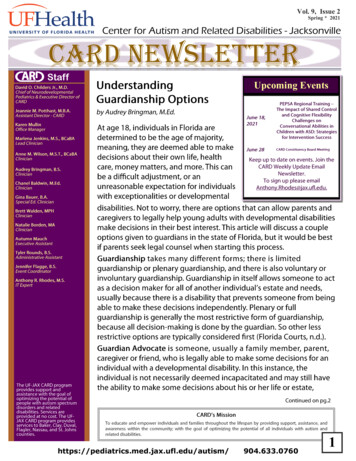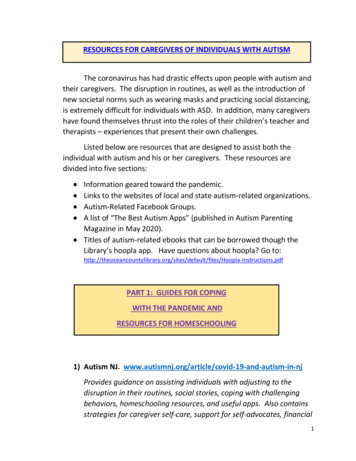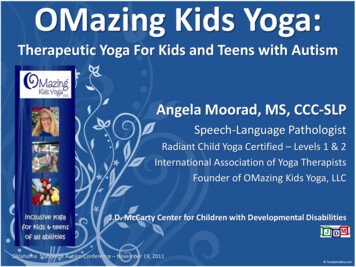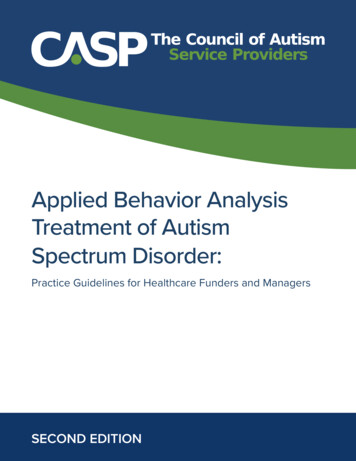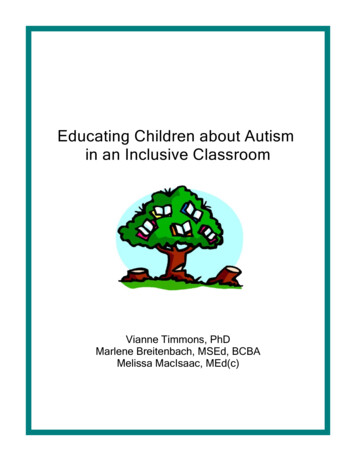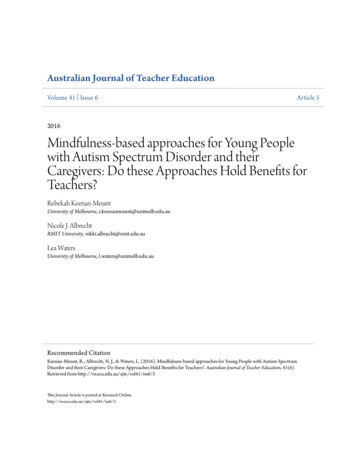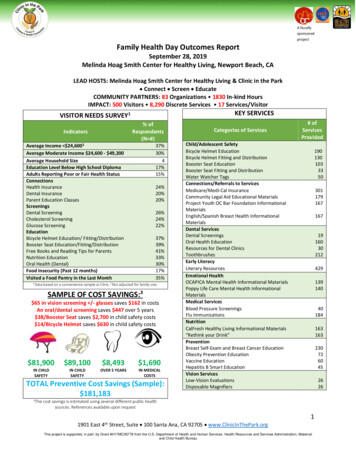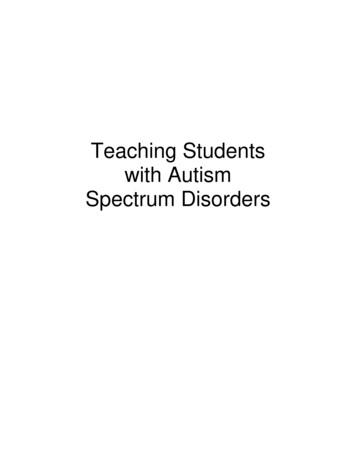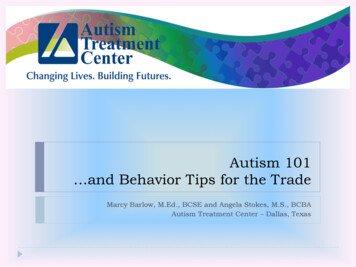
Transcription
Autism 101 and Behavior Tips for the TradeMarcy Barlow, M.Ed., BCSE and Angela Stokes, M.S., BCBAAutism Treatment Center – Dallas, Texas
What is Autism?} } } Autism is a disorder characterized by a severe disruption of thenormal developmental process. Autism is not a disease, it is one typeof pervasive developmental disorder (PDD).Autism Spectrum Disorder (ASD) and Pervasive DevelopmentalDisorder (PDD) are often used synonymously.Pervasive Developmental Disorders (PDD)/Autism SpectrumDisorders (ASD) are characterized by severe and pervasiveimpairments in several areas of development, such as:} } } } Impairment in socializationImpairments in verbal and nonverbal communicationRestricted and repetitive patterns of behaviorAutism exists on a continuum from mild to severe.} } Learning, responding, and thinking differences result in confusion,frustration, and anxiety expressed in withdrawal, repetitive behaviors,and, sometimes, in aggression or self-injury.Autism can co-occur with other disabilities.
Individuals with Disabilities Education Act(IDEA) – defined } Autism shall mean a developmental disability whichsignificantly affects verbal and nonverbal communicationand social interaction, generally evident before the age ofthree, that adversely affects educational performance.Other characteristics often associated with autism areengagement in repetitive activities and stereotypedmovements, resistance to environmental change orchange in daily routines, and unusual responses to sensoryexperiences. The term does not include children withcharacteristics of the disability category "behavioraldisorder."
What causes autism?} } } } } Multi-causalGeneticsBrain disorder presentfrom birthNeurobiologicalHaving a headcircumference larger thanaverage in the first 1-3years of life
History of Autism} Leo Kanner, 1896-1981} Research paper of 11children with similarities anddifferences published in1943} } } } } Research noted: childrenincluded their inability todevelop relationships withpeople, delay or absence ofspeechcompulsiveness in their needfor sameness and routinerepetitive or stereotypedbehaviors and an overall lackof imaginative playisolated and aloofKanner used the term"autism" to describe them;autism means "self.“} Autism was also often misdiagnosedas early childhood schizophrenia
Facts and Figures} Autism prevalence figures are growing} } } } } } } } } } } (the current annual growth rate is 10-17%)1:300 Texans have autism1 in 68 diagnosis worldwide or 1.5 million individualsMore children will be diagnosed with autism this year than with AIDS,diabetes and cancer combinedAutism is the fastest-growing serious developmental disability in the U.S.Boys are four times more likely than girls to have autismTypically manifests around the ages of 18 months to 3 yearsGenetics are a factor in the cause as are environmental triggersRecent studies have estimated that the lifetime cost to care for anindividual with an ASD is 3.2 millionThere is no medical detection or cure for autismIs found throughout the world in families of all racial, ethnic and socialbackgrounds
How are Autism Spectrum DisordersDiagnosed?} Autism SpectrumDisorders (ASD) arediagnosed from behavioralsymptoms displayed by achild.} A multiple disciplinary teamshould be involved indetermining a diagnosis.(e.g., speech clinician,occupational therapist,audiologist, psychologist,family members, physicaltherapists etc.)
Facts and Myths } MYTH: Children and adults with autism spectrumdisorders do not care about others.} } MYTH: People with autism spectrum disorders cannothave successful lives as contributing members of society.} } FACT: Many people with autism spectrum disorders arebeing successful living and working and are contributing tothe well being of others in their communities. This is mostlikely to happen when appropriate services are deliveredduring the child's free, appropriate, public education years.MYTH: All people with an autism spectrum disorderhave "savant skills", like Dustin Hoffman's character in"Rain Man".} } FACT: Children and adults with an ASD often care deeplybut lack the ability to spontaneously develop empathic andsocially connected typical behavior.FACT: Most people with autism spectrum disorders donot have any special savant skills. Some have "splinterskills", areas of high performance that are not consistentwith other skill levels.MYTH: Certain intensive, behavioral based programs"cure" autism spectrum disorders if they are delivered atthe right age and intensity.} FACT: There is no cure for autism spectrum disorders.Early behavior-based interventions have positive effects onsome children with autism and less note-worthy effects onother children. Early services need to be based onindividual children's needs and learning styles, not basedon programs being sold as "cures" for every child withASD.
Severity Levels Diagnostic and Statistical Manual of Mental Disorders, 5th edition
You get a child to your facility/school who has autism you haveno training, you are unfamiliar with autism. Now what do you do?} Setting Up Your Classroom for a Student with Autism} Use visual supports} Remember students with autism have communicationdeficits they cannot express themselves effectively.Language difficulties may make it difficult for these studentsto understand what is expected of them. They may beconfused about what is happening.} Visual supports can reduce problem behaviors andincrease effective communication interactions for moststudents with autism.} A schedule is a key component of a visual support system Visual schedules can be very powerful because theyhelp an autistic student visualize their actions. It givesthe student information about what will happen andwhen it will occur.} } } Often students with autism have a difficult time understandingpersonal space.} Define personal space by drawing masking tape outlines onthe floor. Make sure there is plenty of room betweendesks.Take time to set up your classroom and once it is set up avoidchanges.} If your classroom will have stations, use furniture to helpdefine these spaces.} Provide a quiet area for your autistic student to go forbreaksChildren with autism pay attention to details and can miss thebig picture. Wall charts and posters can distract from yourteaching. While teaching, try to teach in front of a blankbackground (i.e. a chalkboard with nothing extra written on it).
Visual Support Systems
Visual Support Systems
} } Choice boards: At times your student with autism willneed to make a choice provide a choice board with a listof acceptable activities they can choose from.Social stories provide an individual with accurateinformation about situations your student with autismmay find difficult or confusing. They can be written for aspecific situation for the individual child. The story shouldbe short and the focus should be limited to one or twokey points: the important social cues, the events andreactions the individual might expect to occur in thesituation, the actions and reactions that might beexpected of him, and why.
Tips for working with Students withAutism Spectrum Disorders} } } } } } } } } } Teach language in contextLimit amount of languageEmphasize communication, not speechEstablish routinesCreate choicesUse visual supportsIdentify communicative intent of child’s behaviorKeep directions to 1-2 stepsAllow for sensory breaks (e.g. walks, chewing gum,squeeze ball)Incorporate child’s interest in lessons
Behavioral/Sensory Challenges} Unusual and repetitive movementsof the body that interfere with theability to attend to tasks oractivities} } } } } } hand flapping, finger flicking,rocking, hand clapping, grimacing oreye gazing.Marked distress over changes inseemingly trivial aspects of theenvironmentUnreasonable insistence onfollowing routines in precise detailUneven gross and fine motor skillsNo fear of real dangerApparent over or under sensitiveto pain
} The Faces of Autismhttps://www.youtube.com/watch?v MCEqfvSr0Fchttps://www.youtube.com/watch?v q3McvBCLn5ghttps://www.youtube.com/watch?v PiFBX1pdC0Yhttps://www.youtube.com/watch?v 1i5GTc8HHdo
Autism Treatment CenterProgram OverviewATC strives to improve the lives of children with autism throughoutthe state and across the nation.} The goal for the children is tomake progress and mitigate thesymptoms of autism.} Children also receive: art therapy,music therapy, yoga therapy, dancetherapy, and pet therapy. Becausethese children have deficits in all ofthese areas, these services helpfoster integration, relationships,self regulation, and generalization.
How about autism atThe Autism Treatment Center?} } } } } } Each person in our program follows anindividualized, comprehensive learning programdesigned by a team of teachers, personal careassistants, administrators, various specialists/consultants, and the individual receiving servicesand their parent or guardian.ATC owns and operates 16 group homes in theDallas area.ATC’s Crystal Charity Ball Educational Wingspecializes in providing education to studentswith autism, ages 3 to 22.The Adult Services program offers a variety ofoptions to the adults at ATC. The skills andinterests of the individual are matched withemployment and/or volunteer opportunities thatare either at the Center or out in the communitywith area businesses and other non-profits.ATC Therapy Clinic provides autism-specificoutpatient therapy for children and adults inNorth Texas. Therapy services includeoccupational, physical, and speech.The Autism Treatment Center provides AppliedBehavioral Analysis and holds contracts with BlueCross Blue Shield of Texas, and is an approvedprovider for Tricare for ABA services.
ATC’s Role withThe Hogg Foundation/TNOYS } } } We use our debriefing tomeet with staff after eachbehavior to see whathappened, what we did right,what we can do in the future,and where to go from here.We use data for best practicesin our decision making inplanning and implementation ofbehavior plans for ourindividuals in care that arereviewed every six months(more if needed)Staff meetings – information isshared and victories arecelebrated.
Challenges:} Staffing} } New staff biasesRetention of new staff} Funding} } Children with autism requirehighly specializedinterventions such as ABA,autism specific ST and OTstrategies to develop andmaintain skills needed on adaily basis.One-to-one and one-to-twostaffing ratios is needed at anygiven time to maintainprogress that is attained anddecreasing the level ofsupport can lead to seriousand significant regression,imminent harm to self orothers, and might pose a flightrisk.
Where do we go from here?} } } } ATC has a long history of advocating for theirchildren and helping to shape the growth of theindividuals in care.Each program developed addresses a specificneed for the children and adults needing ourservices.Continue to decrease containments in debriefingtechniques.Current Research at the Center:} Evaluation of the Play Wisely Program inChildren with Autism} } The purpose of the study is to examine theeffectiveness of the Play Wisely intervention forenhancing the parent-child relationship whiledeveloping the essential learning foundation skills inchildren with a diagnosis of autism, pervasivedevelopmental disorder (PDD), or autism spectrumdisorder (ASD).Human-Robot Interaction System forEarly Diagnosis and Treatment ofChildhood Autism Spectrum Disorder} The purpose of this study is to investigate thedifferences in sensory-motor abilities betweenchildren with Autism Spectrum Disorder, and thosewith normal-typical development.
How can I receive more training?} Texas StatewideLeadership for AutismTraining Online} } } http://www.txautism.net/trainingsLocal Region ServiceCentershttp://txautism.esc2.net/} } } Free workshops!30 minutes for professionaldevelopment in 12 differenttopics related to autismSome offered in spanish aswell as having informationgeared for families/caregivers
Marcy Hoover, M.Ed., BCSEBoard Certified in SpecialEducationAngela Stokes, M.S., BCBABoard Certified BehaviorAnalyst10503 Metric DriveDallas, Texas 75243972-644-2076 main line972-644-5650 faxwww.atcoftexas.org
ATC strives to improve the lives of children with autism throughout the state and across the nation. ! The goal for the children is to make progress and mitigate the symptoms of autism. ! Children also receive: art therapy, music therapy, yoga therapy, dance therapy, and pet therapy. Becaus
